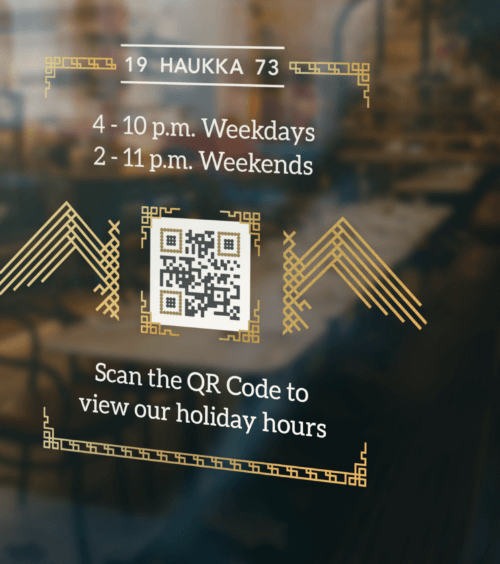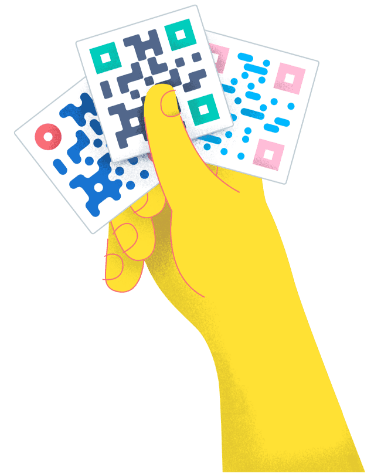How to use QR Codes in Chinese New Year celebrations
Chinese New Year is a hugely-celebrated occasion around the world. For companies, this means you need to adapt your marketing campaigns to target those celebrating Chinese New Year while paying attention to specific culture and traditions. With QR Codes, you can now launch family-friendly Chinese New Year campaigns to boost sales, create brand awareness, and satisfy the needs of your customers.


Event QR Code
Honor customers with a lion or dragon dance event
One of the most popular events during the Chinese New Year is a lion or dragon dance event, often held by companies or cities as a public event or as part of a parade. If you’re planning one to honor your customers or attract the attention of potential ones, make it easy for them to RSVP by adding the Event QR Code on your invites. Print the Code on posters, mailings, or even store windows to keep the designs pristine. Now, all your customers need to do is scan the QR Code, save the date on their calendars and turn up to celebrate on the day of the event.
Learn more

Video QR Code
Foster brand awareness by promoting holiday commercials
Just like any other holiday, Chinese New Year is centered around family, gifts, and commercials. If you’ve made a commercial, why not promote it outside of TV spots to gain more views? With the Video QR Code, you can promote it on any medium you want, even on billboards for everyone to see. Your commercial is displayed on a mobile-optimized page with a customizable button that leads to wherever you want such as your website to encourage sales.
Learn more

Business QR Code
Keep customers updated about business hours during holidays
During Chinese New Year, your business will likely have either extended or reduced office hours. In either case, you can use a Business Page QR Code on your office window or door so that customers can get the latest update on your opening hours. If you own a brick and mortar, you can add a link to your online store in the QR Code to encourage purchases even when the store is closed.
Learn more

Social Media QR Code
Grow social media followers with a giveaway contest
Brands like Coke and Pepsi often create Chinese New Year giveaway contests to grow their social media followers. You can use a Social Media QR Code on your product packaging for the same goal. Customers who scan your QR Code view all your social media profiles on one page so they don’t have to look those profiles up manually. Not only do you make this process seamless, you also don’t have to worry about your customers following the wrong social media accounts.
Learn more

Coupon QR Code
Reward your customers with holiday discounts
Holidays are often associated with discounts. Why not add Coupon QR Codes on your promotional materials to make it easier for customers to redeem them? A tip from us: use the number 8 heavily in your promo code as it is the most prosperous number in Chinese culture. So creating discounts like 88% off or buy 8 get 1 free are ideal for Chinese New Years traditions. The best part about using our QR Code is that you can edit the promo deals even after the holidays are over so you never have to worry if your customer is trying to redeem from the same QR Code. Simply update the Code to avoid disappointing your customers.
Learn moreWhy should you use QR Codes for Chinese New Year
The Chinese New Year is a busy time for business promotions for things like decorations, special events, discounts, and much more. When you combine these promotions with QR Codes, you get the maximum audience reach possible. QR Codes are the perfect bridge between print and digital. They make the process of viewing online content from print fast, easy, and error-free. No more long, ugly links on your marketing collateral, and no more missed sales opportunities due to typos. QR Codes can also be used for much more than just links, too. There are QR Codes for PDF, MP3, Rating, and much more.
Tips to maximize your Chinese New Year campaigns
In order to give your Chinese New Years campaigns that extra special flare, there are a few elements to keep in mind. Take a look below for a few quick tips.
Implement the color red
Chinese New Years celebrations go crazy around the color red. And not just any red, but a dark and luscious red. We highly recommend that any sales and marketing materials prioritize this color so that customers automatically associate it with Chinese New Years.
Match your campaign with current year’s zodiac sign
The other element that comes into play during the Chinese New Year is their zodiac signs, which are the basis of Chinese astrology. There are 12 symbols of animals that represent each year known as zodiac signs. They are used to determine fortunes, relationship compatibility, careers, best times to conceive, and many other aspects of Chinese culture. Visit the full zodiac sign list to view the upcoming ones until 2031. The characteristics associated with these animals as viewed in astrology are seen as having a major influence on how that year unfolds.
Prioritize the number 8 and avoid the number 4
While the luckiest number in Chinese culture is 8, the unluckiest number is 4. So focus all your marketing promotions on the number 8, because anything associated with 4 relates to death.
An overview of Chinese New Year celebrations
Chinese New Year is one of the most important holidays in China as well as in most Asian and some parts of Western countries. It’s a holiday that focuses on family and friends, as well as the celebration of heavenly deities. With unique and rich traditions like Lion and Dragon Dances, city parades, large-scale feasts, and fun zodiac symbols, the Chinese New Year is a celebration like no other.
When is Chinese New Year celebrated?
The traditional Chinese New Year celebration doesn’t have a fixed date, because it’s connected to the Chinese lunar calendar. In 2021, Chinese New Year will be held on February 12th. However, China adopted the Western calendar in 1912, so they also celebrate January 1st as New Year’s Day. Nowadays, many Chinese families celebrate both New Years’ events.
How did Chinese New Year celebration start?
Chinese New Year celebrations began during the Zhou Dynasty, which lasted from 1046-256 BC. That’s also when the term “Nian” or “year” in Chinese appeared in ancient texts. The celebration originally entailed sacrifices to ancestors or gods and worshipping nature in order to bless harvests for the new year.
At this point in history, there was no static date, largely because that’s how the Lunar calendar worked. The Chinese Lunar calendar isn’t static and instead aligns with lunar phases, solar solstices, and equinoxes. It was also reset during the reigns of different emperors. The concept of Yin and Yang (opposing principles that harmoniously complement each other) also influence how the Lunar calendar developed.
The Lunar calendar itself can be traced back to the 14th century BC under the Shang Dynasty. It functioned as a religious, dynastic, and social guide that was originally inscribed with oracle bones as a sort of astronomical record.
During the Han Dynasty (202 BC - 220 AD), Chinese New Year began to take a more permanent form. The celebration always took place on the first day of the month and particular celebration traditions such as burning bamboo for the loud cracking sound began to take shape.
Under the rule of the next dynasty, the Wei and Jin Dynasties (220-420 AD), Chinese New Year became less about worshipping the gods and nature and transformed into a form of personal entertainment. This involved families coming together to clean their houses, feasting together, and staying up late to play games and spend time together.
How is Chinese New Year celebrated?
What we now think of when we hear about the Chinese New Year are the traditions that developed during the Tang, Song, and Qing dynasties that arose during the Chinese Spring Festival (another seasonal celebration). Activities such as Lion and Dragon dances, Temple Fairs, and lantern shows became more popular as the celebrations became more focused on entertainment and socializing.
Fast forward to today and the entirety of Chinese New Year is centered around spending time with family and friends. In addition to the activities mentioned above, families also come together to feast, reconnect, and watch the infamous CCTV New Year Gala that features singers, dancers, and acrobats.
Further traditions include putting up Chinese New Year decorations such as lanterns (always with a focus on the color red), offering sacrifices to ancestors, giving children red envelopes with “lucky money”, and staying up late to await the sound of the New Year Bell. This bell runs at midnight on New Year’s Eve and is a popular tradition that drives away back luck and brings in good fortune.
In some areas of China, celebrations continue for up to 15 days (16 total celebration days) and have regional variations for traditions. This typically involves visiting extended friends and family (for some even the graves of loved ones) for between 3 and 7 days after New Years Day, with a first house-sweep afterward (as long as it’s not on the 2nd day because that sweeps away the good luck accumulated from New Year’s Eve celebrations).
The majority of people return to work on the 8th day, as that’s the luckiest number in China, which is when most businesses reopen as well. On the 15th day, a Lantern Festival marks the end of celebrations. Some people send off glowing lanterns into the sky or put them in water such as into the sea, rivers, or lakes.
FAQ
Depending on your graphic design requirements, you can use a graphic design tool to combine your QR Code image (downloadable after you create it within QR Code Generator) and the rest of your designs. If you’re new to this process, we highly recommend Canva, because it’s easy to use and free.
As long as you choose a type of Dynamic QR Code, you can track all related scan data directly in your QR Code Generator profile. This includes scans by location (city and country), time scanned, unique vs. total scans, and operating device used. If you need further analytics, you can also integrate QR Code campaigns with Google Analytics.
Certain types of QR Codes can be made in bulk. For more information, take a look at our guide for bulk QR Code generation.
Yes, all QR Codes are customizable by color, a frame, and Call to Action such as “Scan Me”, unique edge and pixel styles, as well as your logo in the middle. For more information about how this works, take a look at our guide on QR Code customization.
Have more questions?
Visit our help center

